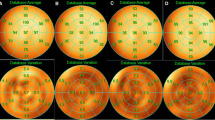Abstract
Objectives. We addressed the question whether in patients with cardiac chest pain referred for stress myocardial perfusion scintigraphy, Tc-99m MIBI SPECT stress imaging should always be followed by a rest imaging procedure. Background. Using Tc-99m MIBI imaging a stress-rest sequence is usually performed implying that the resting study always follows the stress study irrespective of the results of the stress study. As a normal stress study would eliminate a subsequent resting study, it appears desirable to potentially define certain subsets of patients in whom a normal stress study can be expected in order to determine a more selective referral approach to the nuclear medicine department. The consequences of such a more streamlined approach would less impose on the logistics of the department of nuclear medicine, with decrease of investigation time, radiation dose, and costs in a time of retrenchment in the medical sector. Methods. A consecutive series of 460 patients (mean age 58.2 years) was studied who were stratified to 269 patients without prior myocardial infarction, and to 191 patients with documented evidence of a previously sustained mycoardial infarction. All patients underwent Tc-99m MIBI SPECT imaging according to a two-day stress-rest protocol. Results. Patients with and without a previous myocardial infarction showed suboptimal overall predictive accuracies for the exercise electrocardiograms (58% and 60%, respectively). In the total group of 460 patients, 94 (20%) patients showed a normal stress-rest Tc-99m MIBI SPECT; this occurred in 86/269 (32%) patients without a previous myocardial infarction and in only 8/191 (4%) patients with a previous myocardial infarction. Conclusions. Patients with a stress defect at Tc-99m MIBI SPECT imaging should always undergo a resting SPECT study irrespective of the clinical and stress electrocardiographic findings. As patients without a previous myocardial infarction had a normal stress SPECT study in almost one-third (32%) of patients compared to only 4% in patients with a previous myocardial infarction, it may be useful to employ different referral and imaging strategies i.e. a stress-only versus a stress-rest procedure. To schedule referring patients differently according to the presence or absence of a previously sustained myocardial infarction may be cost-saving, less demanding for the nuclear medicine personnel, and patient-convenient. In addition, a stress-only imaging procedure reduces radiation exposure to the individual patient.
Similar content being viewed by others
References
Berman DS, Kiat H, Van Train K, Garcia E, Friedman J, Maddahi J. Technetium-99m sestamibi imaging in the assessment of chronic coronary artery disease. Semin Nucl Med 1991; 21: 190-212.
Berman DS, Kiat H, Maddahi J. The new 99m-Tc myocardial perfusion imaging agents: 99m-Tc sestamibi and 99m-Tc teboroxime. Circulation 1991; 84: 17-21.
Kiat H, Berman DS, Maddahi J. Myocardial perfusion imaging using technetium-99m radiopharmaceuticals. Radiol Clin N Am 1993; 31: 795-815.
Kiat H, Maddahi J, Roy L, Friedman J, Berman DS. Comparison of Tc-99m methoxyl isobutyl isonitrile with thallium-201 imaging by planar and SPECT techniques for assessment of coronary disease. Am Heart J 1989; 117: 1-11.
Maddahi J, Roddrigues E, Berman DS. Assessment of myocardial perfusion by single-photon agents. In: Pohost G, O'Rourke R, (eds). Principles and practices of cardiovascular imaging. Boston: Little, Brown, 1991: 179-21.
Diamond GA, Forrester JS. Analysis of probability as an aid in the clinical diagnosis of coronary artery disease. N Engl J Med 1979; 300: 1350-8.
Ritchie JL, Trobaugh GB, Hamilton GW, Gould KI, Narahara KA, Murray JA et al. Myocardial imaging with thallium-201 at rest and during exercise. Comparison with coronary arteriography, and resting and stress electrocardiography. Circulation 1977; 56: 66-71.
Melin JA, Piret LJ, Vanbutsele RJM, Rousseau MF, Cosyns J, Brasseur LA et al. Diagnostic value of exercise electrocardiography and thallium myocardial scintigraphy in patients without myocardial infarction: a Bayesian approach. Circulation 1981; 63: 1019-24.
Santos-Ocampo CD, Herman SD, Travin MI, Garber CE, Ahlberg AW, Messinger DE et al. Comparison of exercise, dipyridamole, and adenosine by use of technetium 99m sestamibi tomographic imaging. J Nucl Cardiol 1994; 1: 57-64.
Larock MP, Braat SH, Sochor H, Maisey M, Rigo P. Introduction to the basis of nuclear cardiology. In: New developments in myocardial imaging. Martin Dunitz Ltd, The Livery House, London, 1993: 1-16.
Pozzoli MMA, Fioretti PM, Salustri A, Reijs AEM, Roelandt JRTC. Exercise echocardiography and technetium-99m MIBI single-photon emission computed tomography in the detection of coronary artery disease. Am J Cardiol 1991; 67: 350-5.
Berman DS, Kiat H, Van Train K, Garcia E, Friedman J, Maddahi J. Technetium 99m sestamibi in the assessment of chronic coronary artery disease. Semin Nucl Med 1991; 21: 190-212.
Worsley DF, Fung AY, Coupland DB, Rexworthy CG, Sexmith GP, Lentle BC. Comparison of stress-only vs stress/rest with technetium-99m methoxy-isobutyl-isonitrile myocardial perfusion imaging. Eur J Nucl Med 1992; 19: 441-4.
Dilsizian V, Dextras R. Prediction of viable myocardium by thallium reinjection at rest after stress redistribution imaging: a pre and post revascularization study. Circulation 1989; 80: 366 (Abstract).
Kiat H, Berman FDS, Maddahi J, de Yang L, van Train K, Rozanski A, Friedman J. Late reversibility of tomographic myocardial Thallium-201 defects: an accurate marker of myocardial viability. J Am Coll Cardiol 1988; 121: 456-63.
Berman DS, Hachamovitch R, Kiat H, Cohen I, Cabico A, Wang FP et al. Incremental value of prognostic testing in patients with known or suspected ischemic heart disease: a basis for optimal utilization of exercise technetium-99m sestamibi myocardial perfusion single-photon emission computed tomography. J Am Coll Cardiol 1995; 26: 639-47.
Author information
Authors and Affiliations
Rights and permissions
About this article
Cite this article
Schroeder-Tanka, J.M., Tiel-van Buul, M.M., van der Wall, E.E. et al. Should imaging at stress always be followed by imaging at rest in Tc-99m MIBI SPECT?. Int J Cardiovasc Imaging 13, 323–329 (1997). https://doi.org/10.1023/A:1005767823114
Issue Date:
DOI: https://doi.org/10.1023/A:1005767823114




